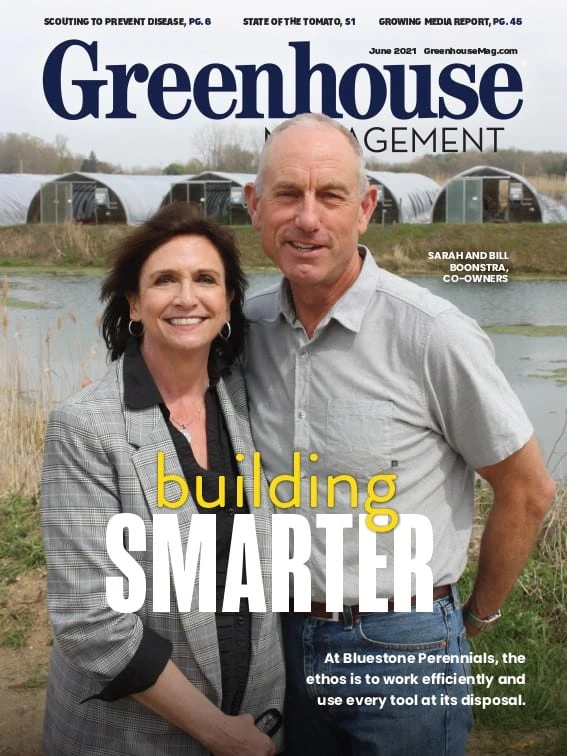

Operation:
Lavocat’s Family Greenhouse & Nursery
Grower:
Chris Lavocat
Location:
East Amherst, New York
Since opening in 1980, Lavocat’s Family Greenhouse and Nursery has served the surrounding areas of East Amherst, New York. While initially under the leadership of parents Don and Teri Lavocat, the greenhouse is now a third-generation operation and far from the original ground to ground greenhouse set up in Don’s backyard, with their kids, Don Jr., Chris and Kellie, and grandsons Jake and Evan now on board.
With a 22,000 square foot garden center and about 34,000 square feet of production space, the operation can offer a full line of over 1,000 varieties of plants, “from everyone’s favorites to the hard-to-find, unusual garden plants” Lavocat’s “About” page says. It also offers annuals, perennials, vegetable plants, fruit trees, herbs, shrubs, hard good items and landscaping services, and has become the largest selection of Western New York State’s houseplants and plant pottery. This said, growing media is an important aspect of the company’s production process.
“In growing media, I am looking for something that dries out,” says Chris, who oversees the garden center, growing space and expansion plans. “You get somewhat of a period of wet conditions and dry conditions, so something that dries out fairly fast, especially for the annual crop, is probably the main thing, along with price.”
As a customer of Lambert Peat Moss, Chris prefers their products because they work for the business and have for years. “The soil just seems to do what we need it to do,” he says.
By using four mixes from Lambert — one for annuals, a mix for perennials, a germination mix for propagation and a lighter mix for their monk crop — Lavocat’s can hone in on the specific need for each item. Some additives that are included in the mixes are bark, perlite and peat.
With no plans of switching growing media suppliers soon, Chris says he will most likely stick to the standard mixes Lambert offers because they’ve worked well thus far.
“If it’s not broke, there’s no reason to try anything else,” he says. “We’re doing fine as-is.”

Operation:
Sokolowski’s Greenhouses
Grower:
Greg Sokolowski
Location:
Clifton Park, New York
Sokolowski’s Greenhouses, a family-owned operation located in Clifton Park, New York, has come a long way from the acreage Bernard and Benita Sokolowski first purchased in the early 1970s. The old barn and dilapidated greenhouses that were housed on the farmland are now 17 greenhouses with 20,000 square feet of growing, and the vegetable plants they first sold have now expanded to annuals, perennials and herbs, too. With everything grown onsite, Bernard wanted to give his customers the highest quality and variety of plants at a reasonable cost by refusing to purchase from wholesalers. With the help of their staff and son Greg, Sokolowski’s continues to do just that, as it serves local retailers and clientele.
“If my plants don’t look like the most premium around, I won’t be happy,” says Greg, who considers himself the pickiest grower and an expert on growing items that aren’t easy to grow.
Although he studied horticulture at SUNY Cobleskill College of Agriculture and Technology, Gregory credits his expertise to the hands-on experience and teachings he received from his father.
As for growing media, Greg says that he has found the best mix in the industry and dares anyone to contest him. His choice for the past 15 years? Berger, “which is by far the number one growing mix out there. Ever since I’ve switched, I’ve never even looked back," he proclaims.
Although Greg uses four mixes — BM 2, a germinating mix for all of his seeds, BM 7 for his perennials and Berger BM 1, an all-purpose mix — BM 6 is his favorite.
"[Berger] is by far the number one growing mix out there. Ever since I've switched, I've never even looked back." — Greg Sokolowski
In the past, Gregory has used other popular growing media companies, but describes those mixes as “mealy” compared to the “coarseness” of Berger. He also appreciates the adaptability of Berger.
“The high-porosity mix that Berger has is the most versatile mix. When I run out of perennial mix, I throw that in there and they thrive,” he explains. “It’s like the nook and cranny mix. If you look at the airspace of the soil, Berger BM6 has more air in the soil than any mix you can buy. There’s just peat moss and perlite in the BM6 and it’s a very generic basic-looking mix, but it’s amazing how stuff grows.”
Although Sokolowski’s has the mix down, one ironic component they encounter while growing is what Greg refers to as “horrible water.”
To combat their water’s high pH and alkalinity, Greg uses sulfuric acid and mixes fertilizers at one and a half ounce per gallon of concentrate. He also waters from a stream instead of from the ground. While it’s not ideal and may be a little primitive, as Greg describes it, he believes he’s an instinctive grower and is good correcting what needs to be adjusted.
What doesn’t need to be adjusted, however, is his love for Berger’s mixes. “I won’t even try anything else,” Greg says. “This stuff is a magical mix.

Explore the June 2021 Issue
Check out more from this issue and find your next story to read.
Latest from Greenhouse Management
- Anthura acquires Bromelia assets from Corn. Bak in Netherlands
- Top 10 stories for National Poinsettia Day
- Langendoen Mechanical hosts open house to showcase new greenhouse build
- Conor Foy joins EHR's national sales team
- Pantone announces its 2026 Color of the Year
- Syngenta granted federal registration for Trefinti nematicide/fungicide in ornamental market
- A legacy of influence
- HILA 2025 video highlights: John Gaydos of Proven Winners





